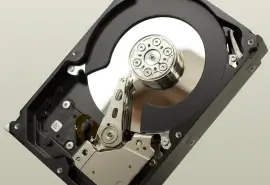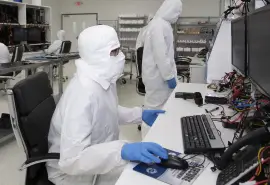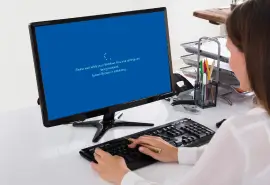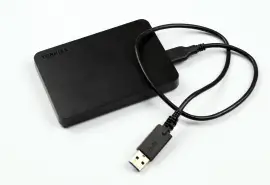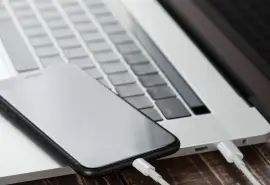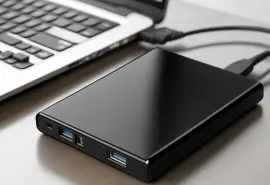If your Lenovo laptop is refusing to turn on, the cause can lie in hardware issues but also in problems with the software or the firmware. Regardless of what caused it, having a laptop that's on the edge of a complete breakdown that leads to data loss is incredibly stressful. At Secure Data Recovery, our experts deal with similar issues on a daily basis, so we're here to guide you through the process of troubleshooting and fixing your Lenovo laptop.
Initial Checks and Power Supply
Before we get into the more advanced diagnostics and troubleshooting, it's important to carry out some basic checks to see whether the problem lies with your laptop receiving sufficient power or having endured visible damage.
- Power indicators: Check your Lenovo laptop's LED indicators that show whether it's receiving power. If there aren't any lights, this suggests that your laptop may be facing a power supply issue.
- Check battery and charger: Examine your Lenovo laptop to ensure that it's either connected to a power source or has enough battery and that its battery is securely seated within your laptop. Look closely at your charger and its cable for signs of visible damage, such as frayed wiring or bent connectors. If you notice any issues, consider replacing the charger to resolve the issue.
- Power outlet test: Try connecting your laptop's charger to a different power outlet to rule out the possibility of electric issues in your current socket. If your laptop starts charging when connected to a different outlet, this suggests that the original outlet was the problem.
- Check for physical damage: Take a closer look at your laptop's physical components, checking carefully for visible damage or loose connections. Check to see whether the power button is stuck or malfunctioning, as this is a common factor that prevents laptops from starting. If you find signs of obvious physical damage, your best bet is to seek professional assistance from an expert or directly with Lenovo's customer support.
- Perform a hard reset: If none of the steps above yielded any results, try a hard reset. Do this by disconnecting the charger and then holding down the power button for 20 seconds. If possible, follow up by removing your laptop's battery. Then, reconnect the battery and power and see if your laptop boots.
If none of this worked, it's possible that there's a problem with your laptop's power supply, which could warrant a visit to a repair store. Before you do that, there are a few more things left to try.
Problem: Software Conflicts

Next, let’s investigate whether there are any software-related glitches or conflicts preventing it from booting up. If your laptop's display works but doesn't get further than its boot screen or the Windows loading screen, it might be due to a software issue.
- First, disconnect all external hardware that's connected to your laptop, such as external storage or peripherals, like a keyboard or mouse. Proceed to reboot your laptop; if it boots successfully, uninstall or update the drivers of the devices you disconnected.
- If disconnecting external devices and rebooting your laptop didn't work, try booting in Safe Mode. To do this, press the F8 or Shift + F8 key during startup, depending on your Lenovo laptop model and Windows version.
- Windows updates or system files can often be the cause of startup problems. If you were able to boot into Safe Mode, try rolling back recent updates or performing a System Restore to a previous stable configuration. To access System Restore, navigate to the Advanced Startup Options in Windows.
- Corrupted file systems or disk errors can sometimes be the reason your laptop fails to start up. To find out whether your system is suffering from disk-related problems, open a Command Prompt window with administrator privileges. To do this, type "Command Prompt" into the Windows search bar, then right-click on what comes up and select "Run as administrator." Next, type "chkdsk /f" followed by your system drive letter (for example, "chkdsk /f C:"). Follow the directions on the screen to schedule a scan, and then restart your laptop.
Problem: BIOS and Firmware Settings
If your Lenovo laptop is still refusing to boot into Windows even though you've ruled out software glitches and power supply issues, the next avenues to explore are your BIOS/UEFI and firmware settings. This will help you find out whether system-level configurations might be the root cause of the problem.
- Access BIOS/UEFI: During your laptop's initial startup, press the key shown on the screen to access the BIOS/UEFI settings. This key will vary depending on your laptop model but typically is DEL, F2, F12, or ESC. Once you're in the BIOS/UEFI settings, make sure the boot order is correctly configured, with the primary boot device set to your laptop's hard drive or SSD.
- Reset settings: If you're unsure about whether your BIOS/UEFI settings may be incorrectly configured, you can reset them to their default state. To do this, locate the option in the BIOS/UEFI to reset settings to default or to load optimized defaults.
- Update firmware: Outdated or corrupt firmware can often be the cause of startup issues. To update your firmware, check Lenovo's official website for updates for your specific laptop model. Follow Lenovo's instructions carefully and precisely to update your firmware without unintended consequences. Typically, you'll need to boot into Safe Mode to initialize the updates, so check out Step 3 of the section on software conflicts to see how to do this.
By thoroughly checking your BIOS/UEFI and firmware settings, you can help rule out the possibility that your laptop's core system configurations are preventing it from booting normally.
Problem: Hardware-Related Issues

If none of the solutions we've run through in this article have helped resolve your Lenovo laptop's boot issue, a hardware malfunction may be at its root. To diagnose this issue, follow the steps below.
Keep in mind that some of the steps involve opening up the laptop to check its components, and this won't be possible on all Lenovo laptop models. Additionally, doing so may void your warranty, so be mindful of this and check your warranty status before proceeding.
- RAM and storage drives: Oftentimes, faulty RAM or storage devices can be the reason behind your laptop being unable to boot. To examine whether your devices are working correctly, you can shut down your laptop and remove the RAM and the HDD or SSD from its bay or slot, then test it on another device.
- Motherboard: Inspect your laptop's motherboard for visible signs of damage or burnt areas. If you're not comfortable doing this yourself, it's best to seek professional assistance, as motherboards can be pretty complex and are often better examined by experts.
- Battery and charger: Verify that your laptop's battery and charger are functioning correctly. If your laptop's battery is integrated and can't be removed, consult Lenovo support for further assistance. If your laptop's battery is removable, consider trying an alternate battery, if available, to see if that resolves the issue.
If the troubleshooting you've just performed doesn't make your laptop start booting properly, it's time to start thinking about professional repairs and data recovery solutions.
Professional Data Recovery
For the majority of cases, the steps we've outlined throughout the article should resolve the issue of your Lenovo laptop failing to boot up. However, this won't always be the case, and you may sometimes need to seek out assistance from repair professionals or directly from Lenovo.
In such situations—particularly if your laptop's SSD or hard drive has failed—your data may be rendered inaccessible if you haven't backed up your files. The good news is that this doesn't mean your data is lost forever.
Secure Data Recovery specializes in recovering laptop data from all popular Lenovo laptop models that fail to boot, including the Lenovo Yoga, Lenovo Legion, Lenovo IdeaPad, Lenovo ThinkPad, and more.
Contact an expert at Secure Data Recovery to get a free quote on recovering data from your Lenovo Laptop.




